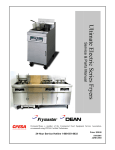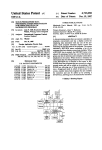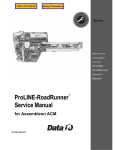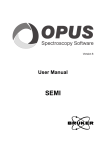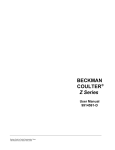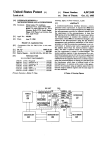Download Apparatus and method for testing of new operating systems through
Transcript
_ US005371879A UnIted States Patent [191 [11] Patent Number: Schif?eger [45] [54] 5,038,281 APPARATUS AND METHOD FOR TESTING OF NEW OPERATING SYSTEMS THROUGH PRIVILEDGED INSTRUCTION TRAPPING [75] Inventor: Cray Research, Inc., Eagan, Minn. A 03017 7 0 2 l 8 E P t. Off. . / 9 9 mopean a OTHER PUBLICATIONS N.J., US; see pp. H; and 12. Apr. 26, 1994 u ' _ Primary Exammer-Robert B. Harrell Attorney, Agent, or Firm-—Schwegman, Lundberg & Related U 8 Application Data [63] 8/1991 Peters ......................... .. 395/DIG. 1 Edition 1985, Prentice—Hall, Inc., Englewood Cliffs, [21] Appl' N°" 233’222 Filed: Dec. 6, 1994 MC68020. 32-Bit Microprocessor User’s Manual, sec. _ [22] Date of Patent: FOREIGN PATENT DOCUMENTS Alan J. Schif?eger, Chippewa Falls, Wis. [73] Assignee: 5,371,879 ' Woessner Continuation of Ser. No. 678,127, Apr. 1, 1991, aban doned. [51] [57] Int. Cl.5 ............................................ .. G06F 9/455 ABSTRACT A method of implementing a privileged instruction that [52] US. Cl. ........................... .. 395/500; 364/DIG. 1; enables the development of new operating systems in 364/280; 364/280.8; 364/280.9; 364/282; user mode. The instruction decode logic includes a 364/975.4; 364/976; 364/976. 1; 364/976.2 maskable interrupt generator that interrupts the proces [58] Field of Search ................ .. 364/DIG. 1 MS File, SO1- during the processing of privileged instructions in [56] 364/DIG- 2 MS File; 395/375, 50o, 700, 800; 371/19 References Cited user mode. An exception handler processes the privi leged instruction interrupt and performs a function similar to the execution of the privileged instruction in Us. PATENT DOCUMENTS privileged instruction mode. The combination of the privileged Instruction Interrupt and the post-mterrupt 4,123,830 12/1978 Cray, 31* 4'253’145 2/1981 GPldberg -- 395/DIG- 1 395/500 exception handling enables the operating system devel oper to test new operating systems by laying them over 4,636,942 .. . the current Operating system .. . l/1987 Chen et a1. 4,661,900 4/1987 Chen et a1. 4,745,545 5/1988 4,812,967 3/1989 Hirosawa et a1. .......... .. 395/DIG. l Schif?eger 4 Claims, 6 Drawing Sheets /1o 12 r 26 INTERRUPT GENERATOR I87 - ] f 30 14 IB1 / ‘Bo , 00 / 28 READ-OUT ‘ "cm INSTRUCTION EXECUTION " UNIT :7 ms'rRuc'noN BUFFERS 24 MODE SELECT US. Patent Dec. 6, 1994 Sheet 4 of 6 5,371,879 405.2 zocbm 2953u2.zéEmpaw3Aulm+5we8z1o:2vwm 52:m9E0?581m8N5Em352”0?.m O _ \ .R/ mZOFhDtEnM 528%6“. I@ JOmFZO, l mm.OE 1 5,371,879 2 length and memory addressing constraints. It also in APPARATUS AND METHOD FOR TESTING OF NEW OPERATING SYSTEMS THROUGH PRIVILEDGED INSTRUCTION TRAPPING cludes the logical address of the processor that per formed the exchange sequence. These are the basic parameters necessary to provide continuity when a 5 program stops and restarts. This is a continuation of application Ser. No. The development of an operating system is a compli cated and time-consuming process which typically re 07/678,127, ?led Apr. 1, 1991, now abandoned. volves around many iterations of software releases. The BACKGROUND OF THE INVENTION difficulty of the task is compounded by the need to test 1. Field of the Invention the system in privileged instruction mode in order to The present invention pertains to the ?eld of high ascertain the function of the privileged instructions. speed digital data processors and more particularly, to a Since an operating system running in privileged instruc method of instruction implementation useful for operat tion mode is free of many of the constraints invoked to ing system development. 2. Background Information 15 An operating system is a collection of programs that controls the execution of other programs in a computer protect other software, operating systems must be de bugged separate from application code. Then the oper ating system must be placed into a realistic environment in which it can be tested performing its control tasks. This problem is compounded in the case of new hard system. Operating system programs reside in processor memory where they coordinate, among other things, ware platforms. In the development of new operating such tasks as 1/0 operations and the execution of back ground tasks and application programs on the system. systems on new hardware platforms, there is a great deal of uncertainty as to whether the hardware, operat ing system or application code is the source of a prob lem. Operating systems free the application programmer from hardware anomalies by, in effect, hiding the hard ware behind a well-behaved and documented interface. In prior art systems, special instructions have been And they improve the ef?ciency of execution of a com 25 provided that ease the task of debugging software. In puter system by managing memory and controlling microprocessors such as the 68000 family by Motorola, a facility is included for “tracing” following each in struction. When “tracing” is enabled, an exception is when a program can execute. As such the performance of the operating system is critical for achieving optimal system performance. Since operating systems perform these critical func forced after each instruction is executed. Thus a debug 30 ging program can monitor the execution of the program tions of program and memory control, processors have under test. evolved with powerful privileged instructions which The 68000 family also features trap instructions. The TRAP instruction always forces an exception and is Typical instructions are those used for I/O control, useful for implementing system calls for user programs. interrupt handling and masking and program control. 35 Other instructions can force trap exceptions on abnor Privileged instructions are typically constrained to exe mal conditions encountered during instruction execu cute in a privileged instruction mode accessible only to tion (such as a division operation with a divisor of zero). operating systems. This is done to protect systems from Although instructions like a TRAP instruction and catastrophic failure due to incorrectly written applica facilities like trace make debugging of application code 40 much easier, they are less useful in the development of tion programs. In the Cray Y-MP manufactured by the Assignee of operating systems. TRAP instructions can be used to the present invention, there are two modes of instruc detect error conditions or to cause an unconditional tion execution: monitor mode and user mode. Privi swap to the operating system. But they are of limited leged instructions run only in monitor mode. If a privi use in program code executing in privileged mode. leged instruction issues while the processor is not in 45 Facilities such as trace create a large amount of over can be used to affect the execution of the machine. monitor mode, it is treated as a no-operation instruction. The operating system of the typical Cray Y-MP computer system manages execution of application pro grams through the use of exchange sequences, fetch sequences and issue sequences. Exchange sequences occur at initialization or when a program is started. An head that can lead to uncharacteristic code execution and may cause one to miss errors in code interactions. This is especially critical in areas of system control such as 1/0. 50 It is clear that there is a need for a method of develop ing operating system code that will promote rapid and exchange sequence moves sets of basic parameters accurate development of new operating systems. What called exchange packages. Parameters currently resid is needed is a privileged instruction that can be executed to a limited extent in user mode without increasing the ing in the operating registers of a processor are moved to memory and, simultaneously, different parameters are loaded to the operating registers. The Cray Y-MP is a multitasking system. That is, it danger of system instability. SUMMARY OF THE INVENTION supports the execution of more than one program in a The present invention is a method of implementing a processor at a time. It also is a multiprocessing system. privileged instruction that enables the development of Therefore a program begun in one processor may be 60 new operating systems in user mode. The instruction swapped to memory and continued later in a different processor. To facilitate this, each exchange package decode logic includes a maskable interrupt generator that interrupts the processor during the processing of contains information that is used to coordinate the tran privileged instructions in user mode. An exception han sition from one program to another. Exchange package dler processes the privileged instruction interrupt and contents describe the state of the processor at the time 65 performs a function similar to the execution of the privi that a program is started or swapped to memory (ex leged instruction in privileged instruction mode. The changed). This information includes the contents of combination of the privileged instruction interrupt and control registers, pending interrupts, current vector the post-interrupt exception handling enables the oper 5,371,879 3 4 Interrupt generator 26 is used to cause an exception on encountering a privileged instruction while in user ating system developer to ‘test new operating systems by laying them over the current operating system. mode. In the preferred embodiment, parcels that begin BRIEF DESCRIPTION OF THE DRAWINGS FIG. 1 is a high-level block diagram of a portion of a with a binary opcode of OOOOOOlXXXXXXYYY (where any one of the X is non-zero and Y is don’t care) or 001 101 IYYYYYYYYY (where Y is don’t care) will vector processor with privileged instruction interrupt generate a privileged instruction interrupt. Exception according to the present invention. handling software in the monitor mode software deter FIG. 2 shows the exchange package used in the vec mines the nature of the interrupt and, on determining it tor processing computing system of the present inven 10 is a privileged instruction interrupt, it mimics the effect tion. of execution of that privileged instruction. This is a FIGS. 3A and 3B show a simpli?ed block diagram of powerful tool that permits the testing of new operating one embodiment of the vector processor shown in FIG. system software in the more forgiving environment of 1. user mode. FIGS. 4A and 4B show a more detailed block dia gram of one embodiment of the vector processor shown in FIG. 1. When the privileged instruction interrupt is enabled, executing a privileged instruction in user mode gener ates an exchange. The privileged instructions act like an DETAILED DESCRIPTION OF THE . error exit or a normal exit instruction. If a privileged PREFERRED EMBODIMENT instruction enters NIP (Next Instruction Parcel) regis In the following detailed description of the preferred 20 ter 18, then an interrupt ?ag is generated which in structs the processor that an exchange must take place. embodiment, references made to the accompanying The interrupt ?ag will shut down the instruction drawing which form a part thereof, and which is shown stream so that no other instructions get into NIP 18 by by way of illustration a speci?c embodiment in which holding P register 16. The processor then sets up to do the invention may be practiced. It is to be understood that other embodiments may be utilized and structural 25 an exchange. The privileged instruction that had en tered NIP 18 will go into CIP 20 and be executed as a changes may be made without departing from the scope NO-OP because of user mode. Following this, the ex of the present invention. change takes place. FIG. 1 illustrates a portion of processor 10 with privi leged instruction interrupt according to the present The exchange brings in the operating system. Once invention. Processor 10 includes an instruction execu the privileged instruction was issued out of CIP 20, the processor set a flag in the exchange package that tells . the operating system that a privileged instruction had issued in interrupt mode and that this is why the ex tion unit 28 connected to current instruction parcel (CIP) register 20, lower instruction parcel (LIP) regis ter 22, lower instruction parcel 1 (LIP1) register 24, change occurred. In this fashion, when the exchange interrupt generator 26 and mode select 30. Current instruction parcel 20 is connected through next instruc 35 takes place, P register 16 is pointing at the instruction after the privileged instruction. tion parcel (NIP) 18 to two read-out registers 14 which The operating system decrements P register 16 in are connected in turn to the eight instruction buffers order to ?nd the location of the privileged instruction. 12.1 through 12.8. Program address register 16 is con It then looks at the instruction, branches to a subroutine nected to read-out registers 14 and instruction buffers 12.1 through 12.8. Program address register 16 provides 40 written to emulate the instruction and initiates an ex the address into buffers 12. Even-numbered words are change back to the original calling program. The privi leged instruction interrupt can be masked by clearing a loaded into one of the read-out registers 14, while odd bit in one of the operating registers that make up the numbered words are loaded into the other. Instruction exchange package. In FIG. 1, mode select 30 is that buffers 12.1 through 12.8 serve as intermediate storage for instructions fetched from main memory (not 45 operating register. Clearing a bit in mode select 30 dis ables the privileged instruction interrupt. Subsequent shown). They function as an elementary instruction privileged instructions are treated like no-operation caching function. (NOP) instructions in user mode as in the Y-MP above. In the preferred embodiment, instructions can be one, The preferred embodiment of the exchange package two or three parcels long. Each parcel is sixteen bits. Next instruction parcel register 18 receives an instruc 50 for the present invention is shown in FIG. 2. Exchange package 50 is a l6-word block of data in memory associ .tion parcel from one of the readout registers 14. While ated with a particular computer program. Exchange the instruction is held in register 18, it is decoded to package 50 contains the basic parameters necessary to determine if the instruction is a one, two or three parcel provide continuity when a program stops and restarts instruction. The parcel is then passed on to current 55 from one section of the program to the next. The ex instruction parcel register 20. Current instruction parcel register 20 receives the parcel from register 18 and holds it until it issues. Issue change package also holds the contents of the address (A) and scalar (S) registers. The address and scalar of an instruction can be held for such things as resolu tion of an access to a shared register. Once issued it is registers, along with the exchange package used in the executed by instruction execution unit 28. Lower instruction parcel register 22 and lower in struction parcel 1 register 24 are used to hold the second and third parcels of an instruction, respectively, when applicable. The full instruction is then presented to 65 instruction execution unit at instruction issue. patent application No. 07/618,748 ?led Nov. 27, 1990, present invention are described in more detail in US. entitled “Vector Shift By ‘Vo Shift Count in Vector Supercomputer Processor”, which application is incor porated herein by reference. Table 1 describes the bit assignments for the interrupt modes, ?ags, status, and mode (“MM”=monitor mode). TABLE 1 INTERRUPI‘ MODES 5,371,879 5 TABLE l-continued IRP IUM IFP IOR IPR INTERRUPT ON REGISTER PARITY ERROR INTERRUI’I' ON UNCORRECTABLE MEMORY ERROR INTERRUP'I‘ ON FLOATING POINT ERROR INTERRUPT ON OPERAND RANGE ERROR INTERRUPT ON PROGRAM RANGER ERROR FEX ENABLE FLAG ON ERROR EXIT (DOES NOT DISABLE EXCHANGE) IBP ICM IMC IRT IIP IIO IPC IDL IMI FNX INTERRUPI‘ ON BREAKPOINT INTERRUPT ON CORRECTABLE MEMORY ERROR INTERRUPT ON MCU INTERRUPT INTERRUPT ON REAL-TIME INTERRUPT INTERRUP'T ON INTER-PROCESSOR INTERRUPT INTERRUI'I' ON I/O INTERRUPI‘ ON PROGRAMMABLE CLOCK INTERRUPT ON DEADLOCK INTERRUP'I‘ ON 001 (i,j NOT EQUAL 0) OR 033 INSTRUCTION ENABLE FLAG ON NORMAL EXIT (DOES NOT DISABLE EXCHANGE) W RPE REGISTER PARTY ERROR MEU MEMORY ERROR - UNCORRECTABLE FPE ORE PRE FLOATING POINT ERROR OPERAND RANGE ERROR PROGRAM RANGE ERROR EEX ERROR EXIT (000 ISSUED) BPI BREAKPOINT INTERRUPT MEC MEMORY ERROR - CORRECTABLE MCU RTI ICP MCU INTERRUPT REAL-TIME INTERRUPT INTER-PROCESSOR INTERRUPT 101 V0 INTERRUPT (IF IIO & SIE) PCI PROGRAMMABLE CLOCK INTERRUPT DL M11 DEADLOCK (IF IDL 8: NOT MM) 001 (i,j NOT EQUAL 0) OR 033 INSTRUCTION INTERRUPT (IF IMI & NOT MM) NORMAL EXIT (O04 ISSUED) NEX STATUS PS PROGRAM STATUS WS WAITING ON SEMAPHORE FPS VECTORS POINT STATUS VNU VECTORS NOT USED MODES MM MONITOR MODE BDM ENABLE BI-DIRECTIONAL MEMORY ESL ENABLE 2nd VECTOR LOGICAL C90 C90 MODE In the preferred embodiment, processor 10 is a vector processor for use in a multiprocessor vector supercom puter. FIGS. 3A and 3B are simpli?ed block diagrams To use the present invention, one would set the privi leged instruction mask bit in the exchange package to enable the privileged instruction interrupt. The new operating system software would be loaded in memory of a vector processor 60. The preferred embodiment is 40 a multiprocessing system with sixteen processors. How and an exchange sequence initiated that starts the new ever it should be obvious that the present invention is operating system program in user mode. At each occur rence of a privileged instruction in the operating system independent of the number of processors. FIGS. 4A and 4B are more detailed block diagrams under test an interrupt would be generated that causes an exchange to the current operating system. Exception of the same processor 60. Each processor 60 contains eight vector registers V0-V7. The vector registers handling software would then determine the source of V0-V7 each contain 128 words, each word consisting the interrupt and the code to be executed that would of 64 bits. For example, vector register V0 contains provide a state similar to the execution of the privileged words V0Q—V0127. The vector registers are interfaced to instruction. For example, in the preferred embodiment, functional units which perform various logical and 50 the instruction used to set up an I/O channel is a privi arithmetic functions on data from the vector registers. The functional units are fully segmented with latches so tem, it should become necessary to set up an I/O chan that operands can be sent to a functional unit on succes nel, the I/O channel privileged instruction will be is leged instruction. If, in testing the new operating sys sive clock periods. Therefore, during the execution of sued. This will result in an interrupt and an exchange an instruction, each part of a functional unit may be 55 into monitor mode. Once in monitor mode, the real operating system will, with its knowledge of the current operating on a different operand. Also, each functional unit may operate independent of the other functional state of the machine, assign an I/O channel by issuing a units so that more than one result may be obtained from privileged instruction. The operating system will then clear the interrupt and perform an exchange back into the functional units for each clock period. When exchange package 50 (as shown in FIG. 2) is 60 the operating system under test in user mode. Unlike the transferred from shared memory 12 to a processor 60, exchange package 50 is broken up and the portions are saved in different storage areas of processor 60. Bits 32-63 of words 0-7 are stored in exchange parameter trace mode, exceptions are encountered rarely so there is little difference in system performance. And, unlike a typical TRAP instruction, traps are performed on code that is an integral part of the ?nal software. The TRAP registers 74 (shown in FIG. 3B). Bits 0—31 of words 0-7, 65 locations do not have to be rewritten to remove the test are stored in A registers 72 (as shown in FIG. 3A and 4B). Finally, the remaining words 10-17 are stored in S registers 70 (as shown in FIGS. 3A and 4A). points. Although the present invention has been described with reference to the preferred embodiments, those 7 5,371,879 skilled in the art will recognize that changes may be made in form and detail without departing from the spirit and scope of the invention. What is claimed is: 1. An apparatus for debugging a new operating sys logic state; providing a sequence of instructions, wherein the sequence of instructions includes a ?rst instruction followed by a second instruction and wherein the tem within user mode of a processor having a privileged instruction execution monitor mode wherein privileged ?rst instruction is a privileged instruction; storing the ?rst instruction in the current instruction instructions are executed and a user mode wherein a privileged instruction is typically treated as a no-opera register; tion instruction, the processor comprising an instruction if the mode select bit is in the first logic state: execution unit which executes an instruction parcel having an opcode, the processor further comprising a current instruction parcel register, connected to the instruction execution unit, which receives the instruc tion parcel before passing the instruction parcel to the instruction execution unit, the apparatus comprising: 8 interrupt generator and a mode select register com prising a mode select bit having a’?rst and a second generating, from the interrupt generator to the instruction execution unit, a hardware interrupt associated with the privileged instruction; 15 performing a packet exchange sequence to enter privileged instruction executing mode; executing, in privileged instruction mode, a series processor interrupt means, connected to the current of instructions which emulate execution of the instruction parcel register and the instruction exe cution unit, for generating a hardware interrupt to privileged instruction; and returning to user mode to fetch the second instruc said instruction execution unit on encountering a tion; and privileged instruction during user mode, wherein otherwise, treating the ?rst instruction as a NO-OP the processor interrupt means comprise an inter instruction and fetching the second instruction. rupt generator which generates the hardware inter 4. A method of testing program code for a new oper rupt when the instruction parcel opcode received by the current instruction parcel register is associ 25 ating system in a computer having both a user mode and a privileged instruction executing monitor mode, ated with a privileged instruction; and wherein the program code includes a privileged instruc interrupt enable means connected to said processor tion, the method comprising the steps of: providing a hardware interrupt circuit for generating a hardware interrupt when the privileged instruc interrupt means for disabling said hardware inter rupt, wherein the interrupt enable means comprise a mode select register connected to the interrupt generator, wherein the mode select register com prises a mode select bit which operates to prevent tion is detected while the computer is in said user mode; enabling the hardware interrupt circuit; issuance of the hardware interrupt by the interrupt generator. 2. The apparatus according to claim 1 wherein said 35 interrupt enabling means further comprise means for changing the mode select bit under control of an ex placing the computer in user mode; loading the new operating system and executing the new operating system program code within the user mode; trapping the privileged instruction, wherein the step of trapping the privileged instruction comprises: detecting the privileged instruction; and generating the hardware interrupt when the privi leged instruction is detected; change packet. 3. A method of emulating an operating system having a privileged instruction within user mode of a vector processing computer having both a user mode and a privileged instruction executing monitor mode, com prising the steps of: switching to the monitor mode; and emulating the privileged instruction. providing a processing unit comprising an instruction execution unit, a current instruction register, an 45 50 55 65 * * * * *












![Umted State Patent [19] [11] 4,142,232](http://vs1.manualzilla.com/store/data/005874596_1-c39d4064b00ab778afe28c128abc9f97-150x150.png)
